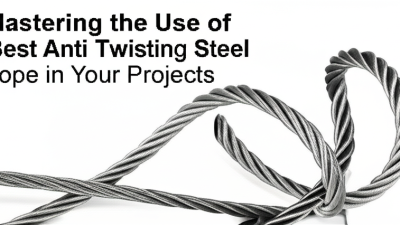Mastering the Use of Best Anti Twisting Steel Rope in Your Projects
In today's construction and industrial sectors, the demand for reliable and efficient lifting equipment is more critical than ever. According to a recent report from the Global Rope Market, the demand for specialized ropes, including Anti Twisting Steel Rope, has surged by over 25% in the past five years, driven by advancements in technology and an uptick in infrastructure projects.
The unique design of Anti Twisting Steel Rope minimizes the risk of entanglement and enhances safety, making it an essential component in various applications ranging from marine operations to heavy machinery. As industries continue to evolve, understanding how to effectively incorporate this type of rope into your projects is paramount for maximizing efficiency and ensuring safety standards.
In this ultimate guide, we will delve into the key features, benefits, and best practices for mastering the use of Anti Twisting Steel Rope in your endeavors.
Understanding the Importance of Anti-Twisting Steel Rope in Project Applications
Anti-twisting steel ropes play a crucial role in various project applications where safety and efficiency are paramount. These robust ropes are specifically designed to minimize the risk of twisting during use, making them essential in industries such as construction, marine, and telecommunications. According to a recent industry report by the International Steel Wire Rope Group, improper rope management can lead to up to 50% more wear and tear, resulting in increased costs and safety hazards. Thus, understanding the unique features of anti-twisting steel ropes can significantly enhance project reliability and longevity.
When selecting the right anti-twisting steel rope for your project, consider the load capacity and environmental conditions. Each project has specific demands that impact the performance of the ropes used. It’s vital to match the rope’s specifications with the project’s requirements. **Tip:** Always refer to manufacturer guidelines to determine the appropriate rope diameter and length, as these factors directly affect the safety and efficiency of lifting operations.
In addition to choosing the right type of rope, regular maintenance is key to extending the lifespan of your anti-twisting steel rope. Routine inspections can help identify signs of wear and prevent potential failures. **Tip:** Implement a maintenance schedule that includes checking for kinks and frays, which can compromise both performance and safety. By adhering to these best practices, you can ensure that your projects run smoothly and safely.
Key Features to Look for in Anti-Twisting Steel Rope
When selecting the best anti-twisting steel rope for your projects, understanding key features is crucial. One of the primary characteristics to evaluate is the rope's lay length, which significantly affects its resistance to twisting. According to industry reports, ropes with a lay length ratio of 1:10 are optimal for minimizing torque under load, ensuring that the rope remains manageable and reduces wear over time. This is especially important in applications where consistent tensioning is required, such as in cranes and construction rigging.
Additionally, the construction of the rope plays a vital role. Multi-strand construction increases flexibility and strength while offering resistance to bending fatigue. Data from the International Society of Rope Professionals indicates that ropes featuring a 6-strand construction can outperform traditional designs by up to 30% in terms of durability. Furthermore, the materials used in coating the rope provide essential protection against environmental conditions. Ropes treated with high-performance polymers can reduce abrasion and corrosion, extending the lifespan significantly. When sourcing anti-twisting steel ropes, prioritize these features to ensure optimal performance and safety in your projects.
Best Practices for Implementing Anti-Twisting Steel Rope in Construction Projects
When incorporating anti-twisting steel rope into construction projects, it is essential to understand the best practices that enhance safety and efficiency. One fundamental practice is selecting the appropriate rope type based on the specific demands of your project. Anti-twisting steel ropes come in various specifications, and choosing one that fits the load requirements and environmental conditions will prevent potential failures and ensure operational integrity.
Proper installation techniques also play a crucial role in the effectiveness of anti-twisting steel ropes. It is vital to ensure that the rope is correctly aligned and tensioned during setup to minimize the risk of twisting or kinking during use. Regular inspections should be implemented to monitor the condition of the rope and its fittings, as any signs of wear can compromise safety. Additionally, training personnel on the correct handling of these ropes can greatly reduce the likelihood of accidents and extend the lifespan of the equipment, ultimately contributing to a more successful project outcome.
Common Mistakes to Avoid When Using Anti-Twisting Steel Rope
When using anti-twisting steel rope in your projects, avoiding common mistakes can substantially enhance efficiency and safety. One prevalent error is neglecting the proper handling and storage of the rope. According to the International Organization for Standardization (ISO) report ISO 4309, improper storage can lead to kinks and twists, which compromise the rope's operational integrity. Ensuring that the rope is stored in a dry environment and properly coiled avoids these issues, maintaining its performance over time.
Another mistake is the miscalculation of load limits. The Wire Rope Institute's guidelines emphasize that exceeding the working load limit (WLL) can lead to catastrophic failures. Many users fail to account for dynamic loads during operations, which can be two to three times the static load. It is crucial to incorporate safety factors into your calculations. Always refer to manufacturer specifications for the anti-twisting steel rope you are using, as these guidelines are designed to provide maximum safety and longevity for your projects. Proper education and awareness pave the way for effective utilization of these robust materials.
Maintenance Tips for Extending the Lifespan of Your Steel Rope Solutions
When it comes to extending the lifespan of your steel rope solutions, proper maintenance is essential. Regular lubrication of drive chains plays a crucial role in preventing wear and tear, enhancing performance, and prolonging operational life. According to industry statistics, poorly maintained chains can lead to a 30% decrease in efficiency. Therefore, adopting a routine lubrication schedule not only ensures optimal performance but also safeguards your investment in steel rope applications.
In addition to lubrication, implementing a systematic inspection process can prevent minor issues from evolving into costly repairs. Studies show that proactive maintenance can extend the life of steel ropes by up to 50%, maximizing their durability in various projects. The use of weather-resistant coatings and regular inspections helps identify potential corrosion or fraying early on, ensuring that the steel rope remains reliable and effective in demanding situations. As industries push towards sustainable solutions, maintaining the quality and lifespan of steel ropes becomes not just a practical concern, but a commitment to efficiency and longevity in project management.
Mastering the Use of Best Anti Twisting Steel Rope in Your Projects - Maintenance Tips for Extending the Lifespan of Your Steel Rope Solutions
| Maintenance Tips |
Frequency |
Expected Lifespan Extension |
| Regular Inspection for Wear and Tear |
Monthly |
6 months |
| Proper Lubrication |
Every 3 months |
1 year |
| Avoiding Overloading the Rope |
Always |
Indefinite |
| Cleaning from Dirt and Grime |
Weekly |
3 months |
| Storing in a Dry Place |
Always |
Indefinite |








